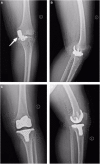The mid-term outcomes of mobile bearing unicompartmental knee arthroplasty versus total knee arthroplasty in the same patient
- PMID: 36761029
- PMCID: PMC9905616
- DOI: 10.3389/fsurg.2023.1033830
The mid-term outcomes of mobile bearing unicompartmental knee arthroplasty versus total knee arthroplasty in the same patient
Abstract
Objective: To compare the mid-term outcomes of unicompartmental knee arthroplasty (UKA) that was performed in one knee and total knee arthroplasty (TKA) performed in the other knee in the same stage.
Methods: This is a retrospective study. A total of 63 patients (126 knees) scheduled for one-stage knee surgery due to osteoarthritis of both knees were selected, and all patients underwent one-stage mobile platform UKA and TKA of the other knee. Differences in general clinical data, functional recovery, complications, and prosthesis revision rates were assessed after UKA and TKA, respectively. The evaluation indicators for knee joint function recovery included the hospital for special surgery knee score (HSS), Joint Forgotten Score (JFS), Knee Injury and Osteoarthritis Outcome Score (KOOS), and Visual analog scale (VAS). Patient preference between UKA and TKA was also recorded.
Results: During a mean follow-up of 76.95 months (range, 65.00 to 87.00 months), there were no significant differences in postoperative complications between the two groups (P = 0.299); however, the prosthesis revision rate was higher in the UKA group than in the TKA group (P = 0.023). The incision length, operation time, blood loss, and postoperative drainage volume in the UKA group were significantly (P < 0.001) lower than those in the TKA group: JFS, ROM, and VAS in the UKA group were higher than those in the TKA group (P < 0.001, P = 0.023, P = 0.032), HSS and KOOS in TKA group were significantly (P < 0.001) higher than those in UKA group. At the last follow-up, 40% and 24% of patients preferred TKA and UKA, respectively.
Conclusions: TKA was found to be superior to UKA in terms of HSS, KOOS, and VAS, while UKA had more significant advantages in terms of less surgical trauma, better ROM, and higher JFS. Complications were not different between groups, but UKA had a higher rate of prosthesis revision. After a follow-up of at least 5 years, more patients preferred TKA.
Keywords: complication; outcome; revision; total knee arthroplasty; unicompartmental knee arthroplasty.
© 2023 Ma, Zhang, Wang, Xu, Ren, Wang, Zhang, Zhao and Yu.
Conflict of interest statement
The authors declare that the research was conducted in the absence of any commercial or financial relationships that could be construed as a potential conflict of interest.
Figures




References
-
- Douglas PM, Peter AD, Geoffrey H. Bilateral total knee arthroplasty: indications and complications. Curr Opin Orthop. (2003) 14(1):52–7. 10.1097/00001433-200302000-00012 - DOI
-
- Di Martino A, Bordini B, Barile F, Ancarani C, Digennaro V, Faldini C. Unicompartmental knee arthroplasty has higher revisions than total knee arthroplasty at long term follow-up: a registry study on 6453 prostheses. Knee Surg Sports Traumatol Arthrosc. (2021) 29(10):3323–9. 10.1007/s00167-020-06184-1 - DOI - PMC - PubMed
LinkOut - more resources
Full Text Sources

